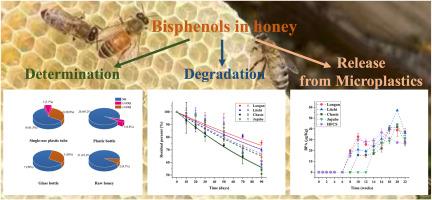基质诱导分散液-液微萃取法检测和降解蜂蜜中的双酚类物质:聚碳酸酯微塑料中双酚A释放的研究
IF 7.3
2区 环境科学与生态学
Q1 ENVIRONMENTAL SCIENCES
引用次数: 0
摘要
保护传粉蜜蜂对生态系统的维持具有重要意义。近年来,双酚类物质(bp)和微塑料(MPs)的污染引起了全球的关注。然而,蜂蜜中bp的降解和bp从蜂蜜中MPs的释放尚不清楚。本文建立了一种新型基质诱导分散液-液微萃取(MI-DLLME) -高效液相色谱-荧光检测法定量蜂蜜中BPA和BPB的方法。该方法利用内源性蜂蜜基质成分促进微提取,提供了一个强大而有效的分析策略。该方法经过严格验证,并应用于67个蜂蜜样本的调查中,结果显示只有BPA可检测到,原始蜂房蜂蜜的污染水平和检测频率明显低于商业蜂蜜。此外,研究了4种植物蜂蜜中BPA和BPB的降解动力学,发现降解速率较慢(0.00344 ~ 0.00647 d -1),半衰期为107 ~ 201 d。此外,在蜂蜜中观察到聚碳酸酯(PC) MPs中BPA的逐渐释放,随着含水量的增加,释放速度加快。这些发现强调了继续监测蜜蜂产品中BP污染的必要性,以保护传粉者和人类消费者的健康。本文章由计算机程序翻译,如有差异,请以英文原文为准。

Detection and degradation of bisphenols in honey using matrix-induced dispersive liquid-liquid microextraction: Insights into the release of bisphenol A from polycarbonate microplastics
The protection of the pollinator honeybee is of significant importance to the maintenance of the ecosystem. In recent years, the contamination of bisphenols (BPs) and microplastics (MPs) has prompted global concern. Nevertheless, the degradation of BPs in honey and the release of BPs from MPs in honey remain unknown. Herein, a novel matrix-induced dispersive liquid-liquid microextraction (MI-DLLME) method coupled with high performance liquid chromatography (HPLC)-fluorescence detection was developed for quantifying BPA and BPB in honey. This approach leverages endogenous honey matrix constituents to facilitate microextraction, offering a robust and efficient analytical strategy. The method was rigorously validated and applied in a survey of 67 honey samples, revealing that only BPA was detectable, with raw apiary honey exhibiting significantly lower contamination levels and detection frequency than commercial honey. Furthermore, the degradation kinetics of BPA and BPB were investigated in four botanical honey types, showing slow degradation rates (0.00344–0.00647 day-1) and half-lives ranging from 107 to 201 days. Additionally, the gradual release of BPA from polycarbonate (PC) MPs was observed in honey, with higher water content accelerating the release rate. These findings underscore the need for continued monitoring of BP contamination in honeybee products to safeguard both pollinator health and human consumers.
求助全文
通过发布文献求助,成功后即可免费获取论文全文。
去求助
来源期刊

Environmental Pollution
环境科学-环境科学
CiteScore
16.00
自引率
6.70%
发文量
2082
审稿时长
2.9 months
期刊介绍:
Environmental Pollution is an international peer-reviewed journal that publishes high-quality research papers and review articles covering all aspects of environmental pollution and its impacts on ecosystems and human health.
Subject areas include, but are not limited to:
• Sources and occurrences of pollutants that are clearly defined and measured in environmental compartments, food and food-related items, and human bodies;
• Interlinks between contaminant exposure and biological, ecological, and human health effects, including those of climate change;
• Contaminants of emerging concerns (including but not limited to antibiotic resistant microorganisms or genes, microplastics/nanoplastics, electronic wastes, light, and noise) and/or their biological, ecological, or human health effects;
• Laboratory and field studies on the remediation/mitigation of environmental pollution via new techniques and with clear links to biological, ecological, or human health effects;
• Modeling of pollution processes, patterns, or trends that is of clear environmental and/or human health interest;
• New techniques that measure and examine environmental occurrences, transport, behavior, and effects of pollutants within the environment or the laboratory, provided that they can be clearly used to address problems within regional or global environmental compartments.
 求助内容:
求助内容: 应助结果提醒方式:
应助结果提醒方式:


